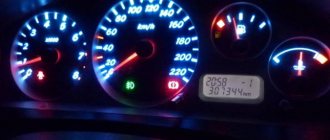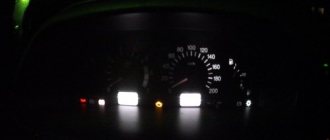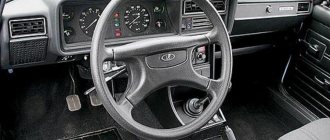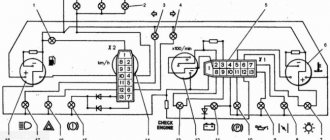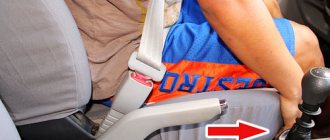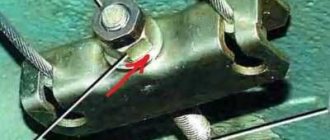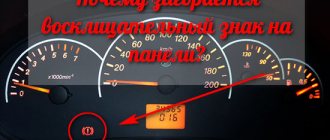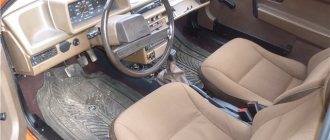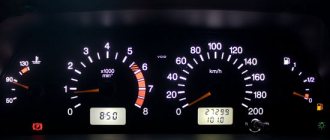The dashboard, also known as the instrument panel, is designed to display important information about the condition of the car
For example, indicators of the current speed of the car, fuel consumption, etc. This area is often located in front of the driver's seat (behind the steering wheel). Less commonly, it is installed on the center console, but tilted towards the driver for easy reading of data.
Note! On average, a modern panel houses about 10 devices. This amount is considered optimal for informing the driver about the condition of the car. If you put less or more, then there may not be enough information, or, on the contrary, the car owner’s attention will be distracted by an overabundance of devices.
Dashboard structure
All torpedo designations can be globally divided into two groups:
- instrumentation - responsible for demonstrating various measurements. For example, mileage, current speed, etc.;
- warning lamps (icons) - their task is to notify the driver with light signals about the condition of certain elements and components of the car. For example, the braking system and battery charge.
The composition of the dashboard is individual for each car and its configuration. But there are a number of devices that are somehow present in every torpedo:
- speedometer (vehicle speed indicator);
- fuel indicator (shows how full the fuel tank is);
- tachometer (engine speed meter);
- odometer (displays the total and daily mileage of the car);
- temperature indicator in the cooling system (displays the temperature of the coolant in the engine).
Based on this set, manufacturers make their own adjustments to the number and composition of the instrument panel.
Note! In modern cars, the indicators of the torpedo instruments are analyzed by the on-board computer. If any measurement does not correspond to the norm, the BC notifies the driver with a notification on the screen. In this way, the car owner will learn about problems that have arisen with brake discs, light optics, and more.
Indicator lamps: decoding backlight colors
Each automaker designs the warning symbols on the dashboard differently. However, a general standard for backlight colors will help you navigate them:
- Green or Blue - These icons are intended to inform you about the vehicle's currently enabled features. For example, headlights or all-wheel drive.
- Yellow (or orange) - notifies of a possible or existing problem, or a problem with functionality that does not require immediate intervention. This could be low tire pressure, etc. Yellow color does not mean a serious malfunction and you can continue driving if this icon lights up. However, during your further journey you should pay special attention to the controls. And fix the problem as soon as possible, without postponing the fix until later.
- Red - this color in most cases indicates a serious malfunction that poses an emergency hazard. Problems of this nature require immediate elimination. Secondarily, such icons are used to inform the driver about the extremely low level of fuel in the tank, battery charge, etc. It is advisable to study what certain icons mean. If the red light comes on and you don’t know what it means, it is recommended to stop the car. Since continuing to drive can be fraught with an accident due to the failure of an important car system, including the engine. But if you intend to drive, then you need to go straight to the service station and drive very carefully.
Some graphic icons are accompanied by a sound signal when activated.
Types of dashboards
There are two types of torpedoes:
- Analog (arrow) ones consist of mechanical parts and are found in old or budget cars. Measuring instruments (tachometer, speedometer and others) are designed in the form of a semicircle and the current value is indicated by an arrow. Control indicators are equipped with lights that light up when the vehicle’s functionality is activated or a malfunction is detected.
- Electronic (virtual) is a more current type of panels installed on many modern cars. They are based on software that displays the necessary information on the screen. The screen and software replace mechanical sensors and instruments, but often virtual solutions visually imitate analog dashboards.
Location and composition of the car dashboard
In the vast majority of cars, all control panel instruments
located on the left directly in front of the driver. In some production passenger cars, the instrument panel is located in the center of the front console, but still turns slightly towards the driver for ease of reading information from it.
Typically, a car's instrument panel includes the following indicators:
- speedometer - speed indicator;
- control lamps for the operability of components;
- total and daily mileage counters;
- temperature indicator in the cooling system;
- fuel level indicator;
- tachometer – engine speed indicator.
This is a basic, standard set of dashboard indicators, which can be changed and supplemented depending on the specific car model. For example, in some modern cars, brake disc wear controllers are installed, from which warning lights are displayed on the dashboard.
Symbols on the instrument panel.
The control and measuring instruments of the vast majority of car models operate on the same principle - red light, this is a problem. That is, the glow of any red light or the presence of the instrument needle in the red zone indicates problems with the car. In this case, it is best to stop and study the problem, and only if it is classified as non-hazardous, move on.
What the experts say
Professional auto shop craftsmen have accumulated extensive experience in reupholstering car panels inside and out. Here is a short list of tips from experts:
- Practice first. Take a small piece of material and drag some object.
- Prepare the surface carefully, because any bump or grain of sand will definitely appear on the fabric (defects are not visible on dense fabrics).
- Take your time, otherwise you will have to tear everything off and start again.
- Remove the backing carefully to avoid the adhesive surface sticking together.
- Do not bring a hot hair dryer close to the material and do not hold it at one point for a long time, otherwise you can easily burn the material.
A cracked or shabby torpedo is not a death sentence. It is easy to put in order, capable of bringing joy to the car owner and arousing the interest of passengers. It is enough to select the appropriate material and allocate some free time for the event.
Testing the condition of vehicle components using dashboard indicators
Not everyone knows that even before driving, the instrument panel may indicate problems with the car. It is easy to see them; it is necessary to carry out a brief test of the systems at the beginning of the daily operation of the machine.
At first the ignition turns on, but the engine does not start. At the same time, a large number of multi-colored light bulbs light up on the panel, the exact composition and colors of which depend on the car model. But in any case, the following indicators should light up:
- pressure lamp in the lubrication system;
- battery health lamp;
- handbrake light.
Next, you should start the engine. Immediately after this, the red “alarm” indicators, with the exception of the handbrake sensor, should go out. To check the serviceability of the handbrake and its controller, you just need to tighten it and lower it back, simultaneously checking the reaction of the corresponding indicator.
Demand for color
Designers advise painting the dashboard in the same color as the interior, choosing a slightly lighter shade. This reduces the strain on the driver's eyes. To make the interior of the cabin original, you can use one of the current colors: anthracite (charcoal color with a dusty effect) or titanium (golden hue with matte or dazzling glossy effects).
Repairing a car dashboard using “liquid rubber” paint is popular. When dry, this composition forms a smooth, rich matte surface, pleasant to the touch and resistant to negative influences.
- EVO tuning
- Moskvich 412 tuning
Dashboard faults
The instrument panel most often contains electronic, light and mechanical devices, and the share of the latter is constantly decreasing. Failures are mainly associated with wear of mechanical parts, failures of the on-board computer and problems in the vehicle’s on-board electrical network. If there is any malfunction in the dashboard, you should immediately contact a specialist, since driving without being sure of the reliability of the panel indicators is extremely dangerous.
Subscribe
to our channel in
Index.Zen
Even more useful tips in a convenient format
The instrument panel (ID) of a car is a unit designed for communication between the units and systems of the vehicle with the driver. Thanks to the indicators on the control panel, the car owner will always know what equipment is working, at what speed the car is moving, how much fuel is in the tank, etc. You can learn more about the description and diagnostics of the device from this material.
The word lives
The word “torpedo” was so simple, understandable and convenient that it very quickly replaced the tricky expressions “instrument panel” or “instrument set” in industrial slang.
Gradually, other suppliers of automotive components came to replace the Torpedo company, but the word took root in the USSR and did not disappear anywhere. In the 50s, it was no longer called instruments, but the front part of the cab with a glove box, a niche for a radio station and other devices for controlling the machine. The front panels on Zhiguli cars, as well as on all Soviet passenger cars, began to be called in the same way.
Description of the dashboard
Let's start with a description of the dashboard. The instrument panel is the general name for the area in which the main control and measuring devices of the vehicle are located. The purpose of these devices is to timely notify the driver of the car about the condition of the main units, mechanisms and systems. In addition to speed and fuel volume, the instrument panel allows the driver to know about the current engine temperature, as well as the mileage traveled.
Location and composition
In most vehicles, the instrument panel is installed above the steering wheel, directly in front of the driver. In some car models, the location of this unit is slightly different - it is placed in the middle of the center console, while it can be slightly turned towards the driver.
As for the composition, the control panel includes the following elements:
- one of the main components of the car dashboard is the speedometer, which shows the speed of the car;
- Also on the panel there are various indicators indicating the performance of certain mechanisms and components;
- odometer showing both mileage and total mileage;
- coolant temperature sensor in the system (motor temperature);
- fuel level controller in the tank;
- tachometer, which allows you to find out the number of crankshaft revolutions.
Any instrument panel has all these elements; they can be called a standard set, but depending on the vehicle, the number of elements can be large. For example, in more modern cars the instrument panel is supplemented with brake disc wear sensors. As for the principle of operation, it is identical in all cases - the red color of the icons is either informational or a warning about problems. Especially when it comes to the appearance of red indicators while the engine is running.
Varieties
There are two types of PP:
- Analogue or pointer type, which was equipped with all old cars.
- Digital or electronic instrument panel. In this case, all the arrows on the sensors and regulators are absent, instead digital symbols are used. The digital panel is a more modern option, however, many motorists believe that such PPs are less accurate due to the fact that the electronics can also make mistakes.
Preparing the surface for painting
The dismantled panel is thoroughly washed from dirt and dust using a high-quality detergent. Next, the surface of the car panel needs to be freed from minor defects. Often, a torpedo has many scratches that formed during its use, and which will be visible even after painting.
Abrasive paper is used to remove defects. If possible, you can use a grinding machine. However, this should be done extremely carefully, since the plastic can very easily be melted by high tool speeds. Thus, the surface of the torpedo is brought to a perfectly smooth state.
After sanding, you should clean everything from dust and degrease the panel. Do not forget that the work is carried out with plastic, so cleaning products should not react with this material. The easiest way is to use alcohol or even a simple soap solution.
Testing the condition of auto components based on tidy indicators
Any universal instrument panel, when turned on, can show the presence of malfunctions in the operation of certain systems even before starting the engine. To see these problems, you simply need to test the node for faults. To do this, you need to activate the ignition, but you do not need to start the engine. At this moment, many different indicators will light up on the dashboard, the color and number of which depends on the specific car model.
But one way or another, when you turn on the ignition, the following indicators should appear on the control panel:
- engine fluid pressure in the lubrication system;
- serviceability of the battery;
- engaging the parking brake.
If we are talking about a diesel car, then when you turn on the ignition, a glow plug status light may also appear on the dashboard. After this, you can start the engine, as a result of which all dials or electronic instruments turn off, with the exception of the handbrake indicator, if it is on. To diagnose the parking brake and its sensor, you should release the handbrake, then tighten it again, while simultaneously observing the PP - the corresponding indicator should disappear there and light up (the author of the video is the sn0ik channel).
After about 20 seconds, you can turn off the engine, and then you need to turn on the ignition again. If there are no problems in the operation of the power unit, then the engine fluid pressure controller will not light up, since the pressure has already increased to normal after starting the engine. If the motor is in normal condition, the indicator should appear no earlier than five seconds after turning off. If the result is different, then this may indicate wear and tear on the power unit. Of course, this diagnostic option will not make it possible to identify all faults in the operation of the motor or other systems.
Liquid vinyl treatment
Liquid vinyl is a modern product that is successfully used for painting car parts. A thin layer of this coating decorates and protects many suitable surfaces well. This is a high-tech product of excellent quality. Treatment with liquid vinyl will increase the resistance of the panel to the influence of bright rays of the Sun, ice, frost or other harmful compounds. The beauty of this substance is that after prolonged use it comes off easily. And this fact does not reduce its strength qualities.
Painting with liquid vinyl is a simple and understandable procedure for everyone. The processed part will become matte and clean. Liquid vinyl is usually sold in cans. Before use, you need to shake it, it is advisable to do this for at least a minute. The paint and solvent must mix well. Do not touch liquid vinyl until it is completely dry. Otherwise there will be stains.
The process takes place in several stages. The initial level is connecting. They try to make it translucent. This makes it possible to bond the paint to subsequent levels. The first layer will dry for about 30 minutes, this time must be maintained. The number of layers applied depends on you. The more there are, the more durable the coating will be. The recommended quantity is five. Distance from the can to the torpedo: 7 - 9 centimeters. If you did not dismantle the torpedo and sealed parts that were not to be painted, remove the tape and protective material immediately after painting, before the vinyl hardens. The complete drying time for vinyl is 3.5 hours. All this time it is necessary to protect the drying surface from dust and other bodies.
Possible faults
As for malfunctions specifically in the PP, they can be as follows:
- Failure of light bulbs. As practice shows, most often car owners are faced with the problem of burnt-out light elements. They can be changed without problems, so there is no need to worry about such a breakdown.
- Wear of mechanical parts of the structure. This problem is relevant for older cars or vehicles in which manipulations were carried out to dismantle and repair the PP.
- Poor contact. Due to poor contact of the connectors, the speedometer, tachometer, engine temperature and fuel volume sensors in the tank may not work. It’s not difficult to solve a malfunction of this kind - you just need to fix the plug, and if the contacts are oxidized, then clean them.
- Failures in the operation of the on-board computer can lead to the inoperability of the PP or the display of incorrect data. It is better to solve this kind of problem with the help of specialists, since interfering with the work of the car’s “brains” is a serious matter.
Tuning with colored LEDs
Recently, tuning the dashboard with the replacement of LEDs instead of conventional lamps has become widespread.
First, LEDs are purchased in accordance with the required filter. The same applies to exterior lighting - front flashers (amber) and brake lights (red).
In addition, you need to purchase an LED dimmer that controls the brightness of the lamps. Without it, LEDs will not work, since LEDs consume much less current than original incandescent lamps. A small PWM (Pulse Width Modulation) is suitable for these purposes. This is a controller based on a 555 timer with a power transistor for switching. The board is integrated into the lighting circuit, which, in turn, ensures the operation of the dimmer.
Overdrive
Overdrive is an overdrive gear with a gear ratio below one. Once upon a time, this term implied the use of an additional gearbox in a gearbox. Today this is the designation for the highest level in an automatic transmission. However, this term is becoming increasingly rare. The last time I saw the O/D (Overdrive) button was next to the selector of the Jatco four-speed automatic transmission, which is installed on Datsun cars. When pressed, the highest fourth gear was disabled.
Poker/stirrer
Kenguryatnik
A kenguryatnik is a tubular structure that is hung in front or behind the car to protect body elements and optics from mechanical damage. Once upon a time, American farmers attached gates to their pickup trucks to disperse livestock. The Russian-language version of the term “kenguryatnik” or “kengurin” came from Australia, where similar designs “roo bar” (literally translated “kangaroo bars”) were hung by truckers to protect the vehicle from animals crossing the road. In particular, from the kangaroo, common in Australia. Today, the kenguryatnik has turned into a fashion accessory and is more often used for decorative purposes and for tuning. As a result of the struggle for the safety of pedestrians, amendments were made to the “Technical Regulations on the Safety of Wheeled Vehicles” that greatly limit the use of such a design.
Overdrive
Manual window lifter (paddle)
Over time, this jargon began to be forgotten, but just a couple of decades ago there were oars in every car. But not so that they can be used to row them to the shore if the car suddenly falls from the bridge into the river. This is what the handles of mechanical window lifters were called. Although many of today's car enthusiasts have never seen such handles. Cars these days are usually equipped with electric windows, while manual ones can only be found in basic versions of budget models.
Tie
Basic symbols
| Icon | Designation |
| A light with an exclamation mark or the inscription Brake indicates that the car's handbrake is on. However, if the indicator appears while driving, it may indicate a problem with the brake system. | |
| If the indicator is red, this indicates a very high engine temperature. When it appears, you need to stop and check whether the coolant is boiling, but it is better not to turn off the car’s engine. If the light blinks, there may be a problem with the wiring. If the icon lights up blue, this indicates that the power unit has not yet warmed up. This indicator always appears when starting a cold engine. It is not recommended to operate the engine under increased loads or at high speeds until this indicator disappears. | |
| Indicates a decrease in the level of engine fluid pressure, and may also indicate its deficiency. | |
| The red battery icon indicates a drop in the voltage level in the car's electrical circuit. In addition, in some cases, such light bulbs appear as a result of the generator not working correctly or there being other electrical problems. Low battery charge. Sometimes the decision to charge the battery helps. |
Additional functions
These indicators are designed to remind the owner of the necessary action, without which operation at the current moment or in the future will be impossible.
- Belt indicator. Informs that he is not fastened and needs to be corrected. In many cars, it starts flashing and beeping as soon as you start driving.
- The interior door is open or not fully closed. The same signal alerts you to similar problems with the tailgate.
- The fuel is running low, the car needs to be refueled.
- The windshield washer fluid is running low and needs to be topped up.
These are the most common warning signs that are worth mentioning.
Lighting devices
Next, we will look at the designations of the icons on the instrument panel that notify the owner about the operation of external lighting elements.
- Exterior lighting is on.
- One of the lamps does not work or there is a problem in the electrical network of the outdoor lighting circuit.
- Active high beam.
- The system automatically switches from high to low beam and vice versa.
- The system for automatically adjusting the angle of the lighting fixtures is faulty.
- The adaptive headlight system is disabled or malfunctioning. The latter is indicated by a flashing icon.
- Automatic low beam switching on during the day is active.
- The brake light or reverse light bulb has burned out.
- Side lights are on.
- The fog lights are working.
- Rear fog lights are on.
- The turn signal or hazard warning is on.
These symbols will help you find your way in time and not misinform other drivers about your intentions (in the case of a turn) or maintain the battery level (if you turn off the external lighting in time).
Signs indicating serious danger
These signals are of great importance. Their presence indicates serious malfunctions in which it is not recommended to operate the vehicle. We advise you to pay more attention to this section.
- This sign indicates that the brake fluid level is below the permissible level. It can also signal a malfunction of the brake system as a whole, wear of the pads or depressurization. And also check the handbrake, perhaps it is on and that is the reason.
- Coolant temperature sensor. If the signal is red, then the temperature has increased and the engine may overheat. A blue glow means a low temperature, which means the engine is not warmed up and it is not advisable to operate it yet.
- A red watering can with a drop indicates critically low pressure in the engine lubrication system. The oil pump has failed or the technical fluid level is low.
- If one of the presented icons appears on the instrument panel, it means that oil should be added to the mechanism; its level has reached critical levels.
- This signal indicates problems with the battery. Lack of charging of the generator, problems with the electrical network.
If you receive such alerts, you should first correct the problem before operating the vehicle.
Security Alerts
This section contains the designations of icons on the instrument panel from the system responsible for the safety of the driver and passengers of the vehicle.
- The appearance of the icon is accompanied by a signal or voice notification. It informs you that it is necessary to close one or more interior doors or the trunk.
- This indicator reports malfunctions of the stabilization system.
- The problem is caused by the passive airbag system.
- The icon notifies you of problems similar to the previous one, but more accurately. In this case, the fault is in the front passenger airbag.
- There is a child in the front passenger seat or the passenger's weight is too low. This may cause the airbag to malfunction in an emergency situation.
- The indicator often triggers erroneously when driving off-road. Indicates that the pre-collision safety system is not working.
- The immobilizer or standard anti-theft system is activated.
- Anti-theft system activation error.
- Automatic transmission error, oil overheating.
- Exceeding the maximum permissible temperature in the automatic transmission. It's better to wait until the gearbox has cooled down.
- Automatic transmission mode "Parking". Relevant for all-wheel drive vehicles with a number of reduced speeds. The machine is blocked.
- If your vehicle has an automatic transmission, this icon indicates low or low oil pressure, overheating, or another problem. In this case, the car automatically goes into emergency mode and moves at a minimum speed to make it possible to get to the service.
- If you see this icon, it means you need to shift to the next gear to reduce fuel consumption.
- The power steering is faulty.
- The handbrake is on.
- The fluid level in the brake system is low.
- High brake pad wear.
- Brake force distribution system error.
- Electric parking brake malfunction.
- The pressure in one or more wheels has been reduced by more than 25%.
- Occurs already during operation and reports that the propulsion systems have malfunctions. May be accompanied by the shutdown of a number of systems until the problem is resolved. At the same time, the system limits the fuel supply to reduce the load.
- The Start-Stop system is activated (green) or malfunctioning (yellow).
- The engine has lost power. Experienced drivers advise stopping the engine for a short time and starting it again.
- Problem with lambda probe. In order not to disrupt the fuel injection function, it is better to turn off the engine and eliminate the malfunction.
- The fuel tank cap is not closed.
- An icon to draw additional attention to an existing problem.
- Problems in the cooling system. The fluid level is low, the temperature is high, and so on.
- The throttle valve is faulty.
- The blind spot monitoring system is malfunctioning.
- It is necessary to change the oil and fuel filters, and at the same time undergo scheduled maintenance. In rare cases, when such icons appear, computer diagnostics of the vehicle is required.
- The engine air filter requires replacement.
- The night vision system and infrared sensors are faulty.
- Automatic transmission overdrive is disabled.
Special systems monitoring indicators
Modern cars are equipped with a lot of special features that simplify their operation. And so that the user can control their operation, the corresponding signals light up on the panel.
- Power mode is active. It is typical for cars with automatic transmission and is designed to delay upshifting. Allows you to achieve maximum engine power, as well as give time for adjustments in the fuel system and suspension.
- Sensors for the mode switching system in automatic transmissions.
- The steering requires repair.
- Variator indicator. Lights up when the ignition is turned on and goes out after a few minutes. Indicates that the system is working properly.
- Active steering system sensor. Indicates incorrect operation. In some situations, this could indicate problems with the braking system or suspension.
- The problem is similar to the previous one. There is a malfunction in the active steering system.
- Overheating of the cross-axle differential, problems in the all-wheel drive system.
- There is a malfunction in the all-wheel drive system or the wheel diameters of the rear and front axles do not match.
- Problems with the transmission of an all-wheel drive vehicle.
- The rear axle differential is locked.
- All-wheel drive is engaged in low gear.
- The transmission automatically switches to all-wheel drive mode.
- Shift into higher gear to save fuel.
- ECO MODE fuel saving mode is active.
- Fuel consumption optimization mode is enabled.
- Lane Tracing Indicators. A flashing yellow signal indicates that the machine is moving to the side and needs to be leveled off or the system is faulty.
- Active or faulty parking assist (depending on color).
- Trailer driving mode is activated.
- The vehicle's chassis is faulty and requires diagnostics.
- Shock absorber operating modes.
- The heated rear window works.
- The braking system is active and will turn off when the gas pedal is pressed.
- Adaptive cruise control is on. If the icon flashes, there is a problem with the system.
- There is an obstacle or vehicle ahead when cruise control is active.
- Snow mode is activated. Essential for comfortable driving in unusual conditions of snowfall and ice.
- The presence of an electronic key and the low state of its battery.
- Electronic key in the car (present or absent).
We have given examples of the most common indicators and described in detail the designations of the icons on the instrument panel. In reality there are many more. If the color design is identical everywhere, then the pictograms may differ depending on the manufacturer, engine type, and so on. It is simply impossible to cover all possible images in one article. Therefore, if you are interested in an icon that is not on the list, write to us in the comments, and we will give a detailed answer to your request. But remember that safety comes first, and if the system is flashing red, it is better to immediately contact a specialist.
Optitronic
Among the varieties of analog panels, the so-called optitron model is distinguished. The name comes from the English “Optitron”, but this is not a technical term, but a trademark of Toyota. With the ignition off, it is almost impossible to see the instruments. They are activated when the ignition is turned on. The arrows light up, then the speedometer, tachometer, fuel level, and parking brake.
Optitronic instrument panel
It is characterized by increased darkness. Thanks to the backlight, the main indicators are visible on the panel, while other indicators are almost invisible. They light up when needed. It looks original and beautiful.
Poker/stirrer
Since we are talking about the gearbox, it is appropriate to remember what the lever of this very gearbox is called in automotive jargon. In common people it is called a poker, for its external resemblance, or a stirrer. The second is more often applied to mechanics, when the lever has to be moved frequently during switching, as if stirring something with a spoon in a cup. You can also often hear about a “handle” or a “stick”.
PS: A whole book could be devoted to automotive jargon - much of everyday life is missing from this post. Therefore, write in the comments what terms confused you at the time and what they meant.
Source

